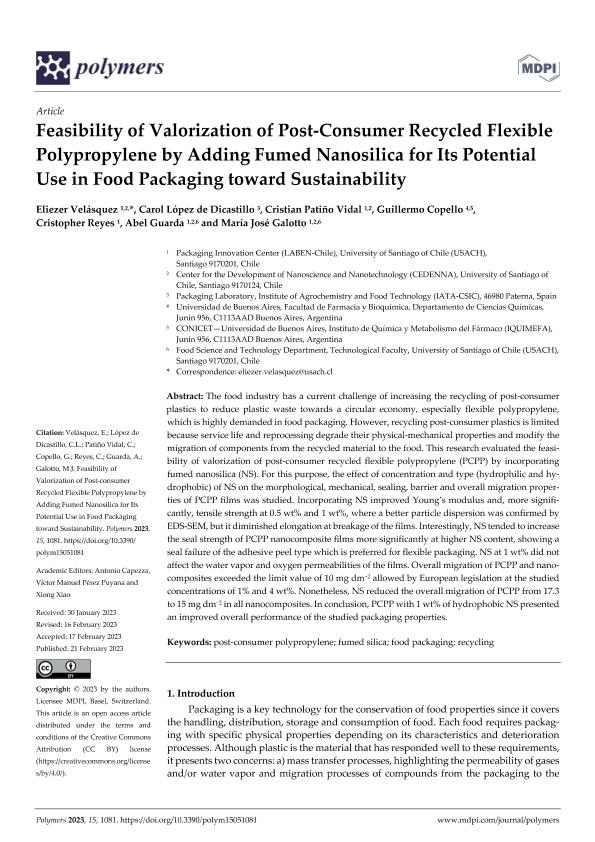Mostrar el registro sencillo del ítem
dc.contributor.author
Velásquez, Eliezer
dc.contributor.author
López de Dicastillo, Carol
dc.contributor.author
Patiño Vidal, Cristian
dc.contributor.author
Copello, Guillermo Javier

dc.contributor.author
Reyes, Cristopher
dc.contributor.author
Guarda, Abel
dc.contributor.author
Galotto, María José
dc.date.available
2024-02-20T15:39:08Z
dc.date.issued
2023-02
dc.identifier.citation
Velásquez, Eliezer; López de Dicastillo, Carol; Patiño Vidal, Cristian; Copello, Guillermo Javier; Reyes, Cristopher; et al.; Feasibility of Valorization of Post-Consumer Recycled Flexible Polypropylene by Adding Fumed Nanosilica for Its Potential Use in Food Packaging toward Sustainability; Multidisciplinary Digital Publishing Institute; Polymers; 15; 5; 2-2023; 1-14
dc.identifier.uri
http://hdl.handle.net/11336/227660
dc.description.abstract
The food industry has a current challenge of increasing the recycling of post-consumer plastics to reduce plastic waste towards a circular economy, especially flexible polypropylene, which is highly demanded in food packaging. However, recycling post-consumer plastics is limited because service life and reprocessing degrade their physical-mechanical properties and modify the migration of components from the recycled material to the food. This research evaluated the feasibility of valorization of post-consumer recycled flexible polypropylene (PCPP) by incorporating fumed nanosilica (NS). For this purpose, the effect of concentration and type (hydrophilic and hydrophobic) of NS on the morphological, mechanical, sealing, barrier and overall migration properties of PCPP films was studied. Incorporating NS improved Young’s modulus and, more significantly, tensile strength at 0.5 wt% and 1 wt%, where a better particle dispersion was confirmed by EDS-SEM, but it diminished elongation at breakage of the films. Interestingly, NS tended to increase the seal strength of PCPP nanocomposite films more significantly at higher NS content, showing a seal failure of the adhesive peel type which is preferred for flexible packaging. NS at 1 wt% did not affect the water vapor and oxygen permeabilities of the films. Overall migration of PCPP and nanocomposites exceeded the limit value of 10 mg dm−2 allowed by European legislation at the studied concentrations of 1% and 4 wt%. Nonetheless, NS reduced the overall migration of PCPP from 17.3 to 15 mg dm−2 in all nanocomposites. In conclusion, PCPP with 1 wt% of hydrophobic NS presented an improved overall performance of the studied packaging properties.
dc.format
application/pdf
dc.language.iso
eng
dc.publisher
Multidisciplinary Digital Publishing Institute
dc.rights
info:eu-repo/semantics/openAccess
dc.rights.uri
https://creativecommons.org/licenses/by-nc-sa/2.5/ar/
dc.subject
POST-CONSUMER POLYPROPYLENE
dc.subject
FUMED SILICA
dc.subject
FOOD PACKAGING
dc.subject
RECYCLING
dc.subject.classification
Físico-Química, Ciencia de los Polímeros, Electroquímica

dc.subject.classification
Ciencias Químicas

dc.subject.classification
CIENCIAS NATURALES Y EXACTAS

dc.title
Feasibility of Valorization of Post-Consumer Recycled Flexible Polypropylene by Adding Fumed Nanosilica for Its Potential Use in Food Packaging toward Sustainability
dc.type
info:eu-repo/semantics/article
dc.type
info:ar-repo/semantics/artículo
dc.type
info:eu-repo/semantics/publishedVersion
dc.date.updated
2024-02-20T13:25:29Z
dc.identifier.eissn
2073-4360
dc.journal.volume
15
dc.journal.number
5
dc.journal.pagination
1-14
dc.journal.pais
Suiza

dc.journal.ciudad
Basel
dc.description.fil
Fil: Velásquez, Eliezer. Universidad de Santiago de Chile; Chile
dc.description.fil
Fil: López de Dicastillo, Carol. Consejo Superior de Investigaciones Científicas. Instituto de Agroquímica y Tecnología de Alimentos; España
dc.description.fil
Fil: Patiño Vidal, Cristian. Centro Para El Desarrollo de la Nanociencia y Nanotecnología; Chile. Universidad de Santiago de Chile; Chile
dc.description.fil
Fil: Copello, Guillermo Javier. Universidad de Buenos Aires; Argentina. Consejo Nacional de Investigaciones Científicas y Técnicas. Oficina de Coordinación Administrativa Houssay. Instituto de Química y Metabolismo del Fármaco. Universidad de Buenos Aires. Facultad de Farmacia y Bioquímica. Instituto de Química y Metabolismo del Fármaco; Argentina
dc.description.fil
Fil: Reyes, Cristopher. Universidad de Santiago de Chile; Chile
dc.description.fil
Fil: Guarda, Abel. Centro Para El Desarrollo de la Nanociencia y Nanotecnología; Chile. Universidad de Santiago de Chile; Chile
dc.description.fil
Fil: Galotto, María José. Centro Para El Desarrollo de la Nanociencia y Nanotecnología; Chile. Universidad de Santiago de Chile; Chile
dc.journal.title
Polymers
dc.relation.alternativeid
info:eu-repo/semantics/altIdentifier/url/https://www.mdpi.com/2073-4360/15/5/1081
dc.relation.alternativeid
info:eu-repo/semantics/altIdentifier/doi/http://dx.doi.org/10.3390/polym15051081
Archivos asociados
